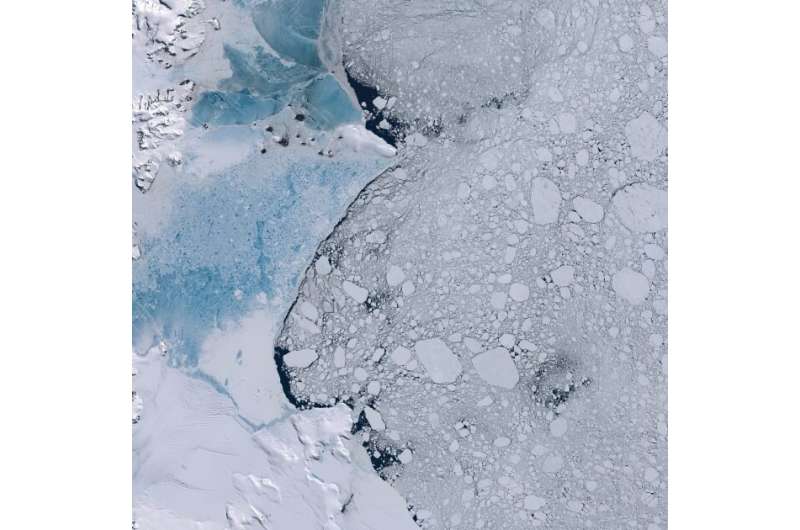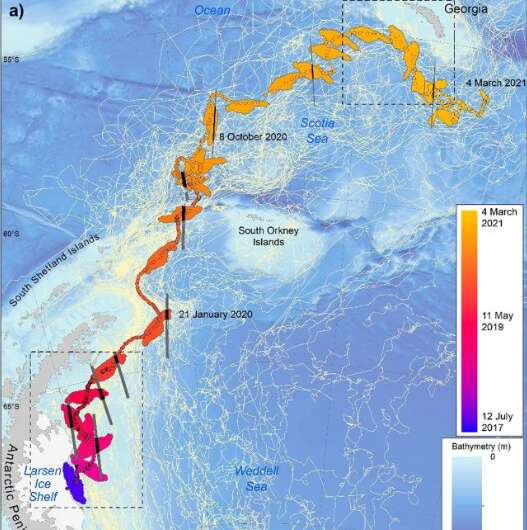Sea ice that slowed the flow of Antarctic glaciers abruptly shatters in three days

In just three days in late January, a mass of ice the size of Philadelphia fragmented from the Larsen-B embayment on the Antarctic Peninsula and floated away, after persisting there for more than a decade. NASA satellites captured the break-up between January 19 and 21, and with it saw calving of icebergs from Crane Glacier and its neighbors as the sea ice no longer buttressed their fronts. Now more vulnerable to melting and acceleration into the ocean, the glaciers that line the Antarctic Peninsula could add directly to sea level.
The Larsen Ice Shelf is situated along the northeast part of the Antarctic Peninsula, in the Weddell Sea. It is divided into four regions that occupy distinct embayments along the coastline, termed Larsen A, B, C and D running north to south, each of which has undergone its own changes in the last few decades. The great mass of the ice shelf holds back the flow of many glaciers from the steep mountains towards the sea, where they contribute to sea level rise. Larsen-A was the first to disintegrate in 1995, followed by the abrupt partial collapse of Larsen-B in 2002. Larsen-C was the fourth largest Antarctic ice shelf as of July 2017, when a giant iceberg, named A68, calved from it, drawing worldwide attention to the region. Being furthest south, and hence least subject to warming, the only portion to be considered relatively stable is Larsen-D.
The loss of 3,250 square kilometers of ice from the Larsen B ice shelf in 2002 has been blamed on warmer ocean waters that melted it from below, and on the presence of meltwater on its surface, which also accelerated the loss of ice. With only a remnant portion left behind following the collapse, this section was much less stable and vulnerable to further disintegration. It grew thinner, which allowed glaciers on the landward side to flow faster. Sea ice formed in the newly opened area each winter, but it was not until 2011 that the sea ice remained year round, and did not melt the following spring. Between 2011 and 2022, the glaciers were somewhat stabilized because the remnant ice-shelf and sea ice that was permanent and attached, fast to the land, blocking their path into the ocean. But this large expanse shattered within three days in January, captured by NASA's Terra and Aqua satellites.

Stef Lhermitte, a professor at TU Delft, who specializes in geoscience and remote sensing, explained to GlacierHub that "[it's] difficult to tell what actually caused the disintegration as the sea ice was already showing cracks prior to the breakup." Others have suggested warmer summer temperatures and foehn winds that carried warm and wet air to the region are partly responsible. The breakup of annual sea ice also occurred earlier than usual this year, which would have also helped destabilize the ice. Nonetheless, "such rapid breakups are often typical for fast ice, as fast ice is often a frozen collection of loose sea ice segments. Once this breaks, it quickly disintegrates," Lhermitte added.
The recent break-up of ice in the Larsen-B embayment is important because the large glaciers that were buttressed by the ice are now exposed to the sea. Unlike sea ice and melt from an ice shelf, glaciers add directly to sea level. Although sea ice frozen to land is not as effective as holding back the flow of glaciers than the original ice shelf that was once present in the Larsen-B embayment, it has played a role in minimizing contributions to sea level rise from the Antarctic Peninsula over the last decade.
At the same time as scientists watched the breakup at Larsen-B, a new study was published that details the life cycle of the huge iceberg that calved from Larsen-C in 2017, A68. It was the sixth largest iceberg ever documented by satellite observations, comparable to the size of Delaware when it first broke from the ice shelf. A68 ceased to exist after three-and-a-half years, when it underwent rapid disintegration near the South Georgia Islands east of the southern tip of South America in January 2021.

Study lead author, Anne Braakmann-Folgmann, who has researched A68, explains that concerns were raised when it calved because "it reduced the remaining ice shelf area by a significant amount [and] Larsen-A and -B had already disintegrated." Iceberg calving is known to influence the stability of the parent ice shelf that it leaves behind, but since 2017, what is left of Larsen-C has remained stable.
With warming temperatures and changing climatic patterns, notable events along the Larsen ice shelf are predicted to occur more frequently. Scientists are able to track each section of the Larsen Ice Shelf closely, documenting ice shelf collapse, growth of sea ice and the long survival of giant icebergs which threaten distant areas. As warming continues, questions prevail over how long the Larsen-D portion will remain stable. Its location closer to the South Pole has protected it from the impacts of climate change—so far. Reducing emissions is not only important for ice on the Antarctic Peninsula, but for the larger East and West Antarctic ice sheets, too.
Image: Antarctica's changing Larsen Ice Shelf
More information: A. Braakmann-Folgmann et al, Observing the disintegration of the A68A iceberg from space, Remote Sensing of Environment (2022). DOI: 10.1016/j.rse.2021.112855
Provided by Earth Institute at Columbia University
This story is republished courtesy of Earth Institute, Columbia University http://blogs.ei.columbia.edu.
No comments:
Post a Comment